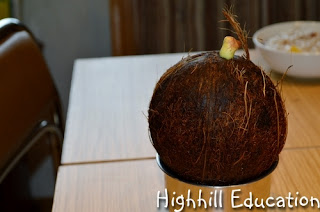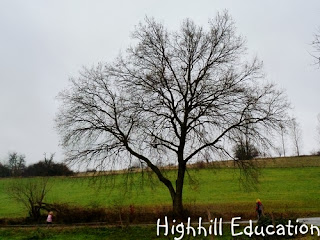This is an eight week, free tree unit study perfect for
kids in grades 3rd-5th which covers tree features, leaves, bark, aging, sprouting and tree shapes. The unit study can be easily adapted to work for
older or
younger children. The lessons are hands-on but also include learning
from books, videos, research opportunities and field trips.
Week 1: Tree Features
- Needle-Like or Scaly Leaves - Conifers
- Simple Leaves - Edges of leaves neither toothed nor lobed
- Simple Leaves - Edges of leaves toothed
- Simple Leaves - Edges lobed and toothed - Fruit is an Acorn
- Simple Leaves - Edges lobed and toothed - Fruit is not an Acorn
- Leaflets - Feather-Like
- Leaflets - Finger-Like
Go on a neighborhood nature walk with your tree guide book. Try to identify different types of trees and notice the unique features that link different types of trees together. Identify tree species if you can, but if not, just try to put the tree into one of the seven different categories. Here are some examples. Yours will be different depending on the trees in your area and the time of year you begin your tree study.
Birch trees tend to have white or light colored bark, the flowers look like caterpillars, the simple leaves are toothed and turn yellow in the fall and they are related to Aspen trees which can be found all over Colorado.
Magnolia trees bloom with large pink and white flowers in the spring.
Horse Chestnut trees are common in our area. They were brought from the Balkins to America and commonly line streets. Just down the street from our house several Horse Chestnut trees line the street. They produce large nuts in the fall. If you find any sprouting trees try to transplant them to a spot where you can watch and care for the baby tree.
Compare two related trees and find ways to tell them apart. For example apple and cherry trees have similar leaves, but cherry trees blossom first and their blossoms are white. Apple tree blossoms are both white and light pink.
The bark on cherry trees is smooth compared to the rougher bark on the apple tree.
Determining differences between trees is one way to learn to look at various features.
Week 2: Tree Age
Each year trees grow they add additional rings around their trunks. If a tree is cut down, you can count the rings of the tree to determine its age. Depending on the amount of rain fall and other weather conditions, the rings may vary in size. In addition, each species of tree grows at its own rate which can result in various diameters for trees of the same age. Go for a nature walk and look for tree stumps. Notice variation in ring size and theorize what may have happened during different years of the tree's life.
If your child really enjoys this activity suggest they keep a notebook to write down tree age data. After collecting enough data on tree species, number of rings and diameter your child could create several different graphs and develop strategies to estimate the age of different trees.
Week 3: Leaves
Make or purchase a simple leaf press and collect and press leaves from different types of trees.
Try to identify the trees and put the leaves into a nature notebook. In the notebook write the tree name, location and date the leaf was collected. Have your child draw the tree. Notice leaf features that are similar. For example, Oak leaves share many similarities in leaf shape, but the leaves can vary greatly in size between species. Notice the shape and size of the acorns. Write about these features in the nature notebook.
Week 4: Apple Trees
The spring is a really great time to learn about apples. When the blossoms appear it is easy to see the girl and boy parts of the flowers. The stamens are the boy parts and are hollow like straws. They stand tall in the middle of the apple blossom. The pistols surround the stamens and are the pollen producing part of the flower.
Visit a fruit orchard if possible and look at an apple blossom. If you don't live near apple trees try to find another fruit tree to visit.
The book How Do Apples Grow? explains how bees pollinate apple blossoms resulting in fruit. After looking at apple blossoms, look at other flowers and try to find the pistols and stamens.
They are easy to see on tulips.
Week 5: Grow a Fruit Tree from Seed
Collect seeds from lemons, apples, plums, peaches, and anything else you bring home from the grocery store. Wrap the seeds in wet paper towels and sprout in a container in the kitchen.
Once the seeds sprout transplant them into soil and label each one.
Care for your seeds by watering them every day.
Week 6: Plant a Pine Tree
Read The Little Fir Tree by Margaret Wise Brown. It is a Christmas story that creates a warm feeling
inside. A fir tree seed blown into an open field sprouts and grows into
a tree. This beautiful picture book is the type to read over and over
doing activities associated with the story each day. There are songs,
seasons, life lessons, animals and other lessons to be drawn from the
story. Getting seeds from cones and sprouting trees is only one fun
activity that goes well with this book.
by Margaret Wise Brown. It is a Christmas story that creates a warm feeling
inside. A fir tree seed blown into an open field sprouts and grows into
a tree. This beautiful picture book is the type to read over and over
doing activities associated with the story each day. There are songs,
seasons, life lessons, animals and other lessons to be drawn from the
story. Getting seeds from cones and sprouting trees is only one fun
activity that goes well with this book.
Have you ever wondered where pine tree seeds come from? I always thought they came from the pine cone, but haven't known how to get them out. My son wondered the same thing and as usual, turned to the internet for the answer. Watch a few videos about where pine seeds come from and then go on a hunt for pine cones.
The chance of getting seeds from a pine cone are much higher if the pine cone has come directly from the tree. Most of the seeds from fallen pine cones have already fallen out or been eaten by animals. If the cone has not opened, heat helps to release the seeds.
Steps for getting seeds from a pine tree.
1. Spy a tree with lots of cones.
2. Throw sticks, rocks or anything you can find at the cones until one falls down.
3. Bang the cone on the ground until the seeds fall out.
Week 7: Plant a Coconut Tree
Coconuts are really seeds. Coconuts purchased from a grocery store can be sprouted and grown into trees. There are at least two methods for sprouting coconuts. One is to place the coconut in a bucket of water with a rock on top of it to keep it under water. The other is to place the coconut in a sealed plastic bag with a small amount of water. Both take between two weeks to three months for the coconut to sprout.
Coconuts don't like cold temperatures, so store your coconut somewhere that the temperature shouldn't drop below 60 degrees F.
Place the coconut in a large plastic bag with a small amount of water.
Here is a coconut sprout after one month.
I recommend sprouting a coconut for any young children interested in plants and science as it is very satisfying.
Week 8: Winter Trees - Identify Trees by Their Shape
In the spring, summer and fall many trees can be easily identified by their leaves and fruit, but in winter when the leaves of deciduous trees fall to the ground the challenge is greater. The simple children's picture book Winter Trees
Read the book, then take a second look at several trees you are familiar with. Here are some examples.
An apple trees has "spooky" branches with sharp bends.
An alder tree has multiple trunks that are shaped like pointy ovals.
An oak tree has a very round shape.
A maple is shaped like the arch of a Gothic window with it's pointy top.
A magnolia looks like an umbrella since the branches are much thicker near the ends.
A birch tree has a V shape and most have double trunks.
A silver lime tree is very triangular.
A horse chestnut tree is oval shaped.
Tree Silhouettes
Create a tree silhouette. Begin by lightly sketching the shape of a tree on watercolor paper. The tree below is an Oak and therefore has a round shape. Lightly draw the trunk. Add big branches by attaching them to the trunk. Then add small branches.
Once the sketches are complete, color them with black sharpie markers.
Draw a line across the page to represent the ground. Paint the background with watercolor paints.
Silver Lime Tree Silhouette (daughter age 12)
Oak Tree Silhouette (by mom)












.JPG)






























No comments:
Post a Comment
Note: Only a member of this blog may post a comment.